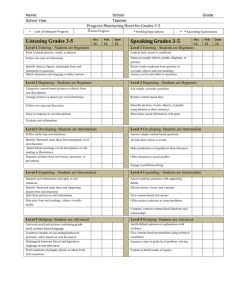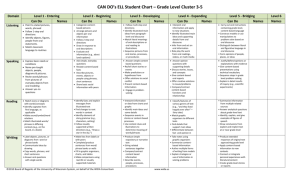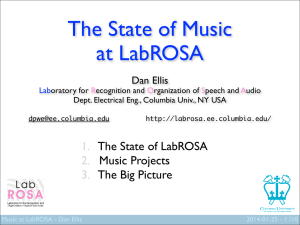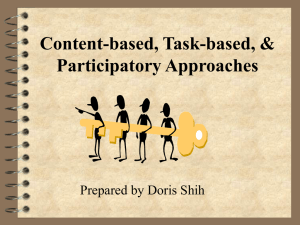Content-based analysis and indexing for speech, sound & multimedia
advertisement
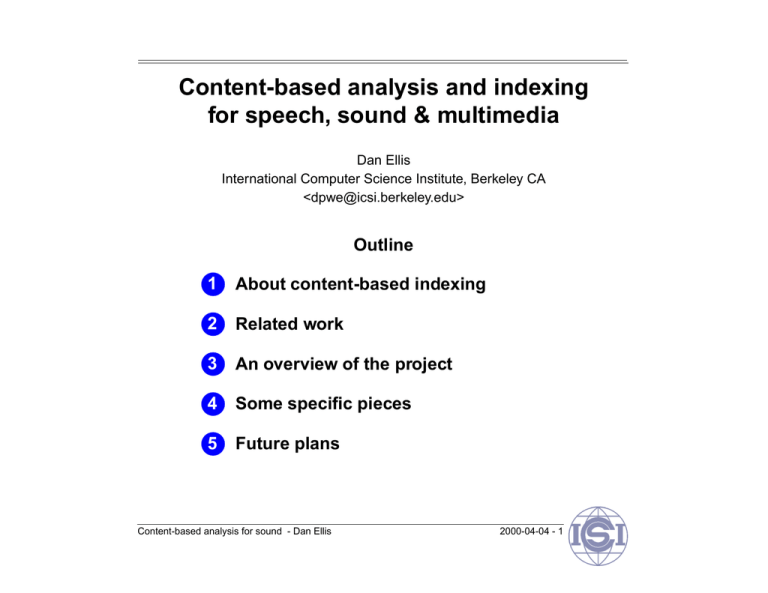
Content-based analysis and indexing for speech, sound & multimedia Dan Ellis International Computer Science Institute, Berkeley CA <dpwe@icsi.berkeley.edu> Outline 1 About content-based indexing 2 Related work 3 An overview of the project 4 Some specific pieces 5 Future plans Content-based analysis for sound - Dan Ellis 2000-04-04 - 1 About content-based indexing 1 • Problem: Automating search in large archives ? Search engine Vast archive • “Information retrieval” (IR) • E.g.: - searching the web - searching broadcast archives - automatic monitoring... Content-based analysis for sound - Dan Ellis User 2000-04-04 - 2 Varieties of Information Retrieval (IR) • Many different search situations: Archive Queries Technology Text terms Text IR (tf • idf, “term space”) Speech terms ASR + Text IR Multimedia terms Text IR on annotations Images, video examples/ sketches Global image similarity metrics Sound examples/ categories Global sound similarity metrics examples object-based similarity terms term-to-feature mapping Sound mixtures - plus combinations (e.g. sound mixtures + video) Content-based analysis for sound - Dan Ellis 2000-04-04 - 3 Content analysis of sound mixtures frq/Hz 4000 2000 0 0 2 4 6 8 10 12 time/s Analysis Voice (evil) Voice (pleasant) Stab Rumble Choir Strings Information Retrieval Query Voice (evil) Voice (pleasant) Stab Rumble Choir Strings • Use local features to find individual objects • Objects must mirror subjective experience Content-based analysis for sound - Dan Ellis 2000-04-04 - 4 Outline 1 About content-based retrieval 2 Related work - Text-based IR - Spoken document retrieval - Image and video retrieval - Multimedia systems - Sound effects indexing - MPEG7 ‘metadata’ 3 An overview of the project 4 Some specific pieces 5 Future plans Content-based analysis for sound - Dan Ellis 2000-04-04 - 5 Text-based IR 2 • e.g. Web search engines • Metric: term frequency • inverse document frequency - emphasizes unusual words - distances in Euclidean ‘term space’ • Decomposition of documents into searchable atoms is (almost) trivial - words are easily isolated, close to ideal terms - some problems, hence stemming Content-based analysis for sound - Dan Ellis 2000-04-04 - 6 Spoken document retrieval • Information retrieval for speech recordings: Convert to text with speech recognition - e.g. Thisl project (news broadcasts) • Speech recognition errors not the limiting factor - TREC-98 results: average precision 0.5→0.4 • Output should be original audio - best not to show the recognizer output! Content-based analysis for sound - Dan Ellis 2000-04-04 - 7 Image and video retrieval • e.g. Query By Image Content (QBIC) (IBM 1995) - templates, color, texture • VideoQ (Columbia 1999) - sketching for images and video - color, shape, size, position, motion • Image ‘objects’? - analog of terms in text - acquired by unsupervised clustering - object frequency • inverse image frequency? Content-based analysis for sound - Dan Ellis 2000-04-04 - 8 Multimedia systems • Informedia (CMU, 1996-) - ASR + video cuts + OCR of screen + IR • AT&T multilevel structuring - exploit knowledge of genre (TV news shows) - multiple special-purpose information sources Content-based analysis for sound - Dan Ellis 2000-04-04 - 9 Sound effects indexing • Muscle Fish “SoundFisher” - browser for sound-effects archives - define multiple ‘perceptual’ feature dimensions - no attempt to separate objects in mixtures Content-based analysis for sound - Dan Ellis 2000-04-04 - 10 MPEG-7 ‘Metadata’ • MPEG is known for audio/video compression standards; also developing standards for use in search and indexing • MPEG-7 will be a standard format for metadata: Well-defined categories for content description • Mostly just framework, some actual categories • How to derive descriptors from content is not specified Content-based analysis for sound - Dan Ellis 2000-04-04 - 11 Outline 1 About content-based retrieval 2 Related work 3 An overview of the project - Boundaries & structuring - Query forms - Summarization - Evaluation 4 Some specific pieces 5 Future plans Content-based analysis for sound - Dan Ellis 2000-04-04 - 12 3 Audio-video content-based retrieval: System overview Boundaries & structuring Speech processing audio Nonspeech analysis Audio-video data IR engine Indexing terms symbolic analogic A-V match video Query Video features Summarization results • Fusion of audio + video (+...?) information • Different query forms Content-based analysis for sound - Dan Ellis 2000-04-04 - 13 Boundaries and structuring • Multimedia documents lack structure • Changes relatively easy to detect - if we don’t have to characterize the change • Audio and video are complementary • Boundaries define structure e.g. stories • May be able to identify genre based on structure pattern (TV, news, interviews, sports) - notice repetition of particular segments (title sequences, commercials etc.) Content-based analysis for sound - Dan Ellis 2000-04-04 - 14 Forms of query • Traditional term-based - mapping of terms to audio/video features? - ... plus all the usual lexical ambiguities - literal vs. thematic terms • Similarity e.g. by example - easy once you have initial hits/documents - but: which aspects of the example? • User-provided example e.g. a ‘sketch’ - better idea of which parts of a sketch are salient and which to ignore - audio sketches? - spoken words? Content-based analysis for sound - Dan Ellis 2000-04-04 - 15 Summarization of results • Multimedia ‘hits’ are hard to present - multi-media → many aspects - some are intrinsically temporal • Video presentation - salient stills/story board - sped-up video • Spoken content - textual summarization based on salience & recognizer confidence - audio selection based on prosodic cues • Audio content - choosing ‘distinctive’ events - visual representation? - timescale modification? Content-based analysis for sound - Dan Ellis 2000-04-04 - 16 Evaluation • Multimedia IR is an emerging field - no consensus on what the task really is - no common evaluation metrics • Evaluation is critical - sanity check on progress - affords ‘fundability’ • How to do it? - quantitative tests e.g. datasets and queries - qualitative user evaluation • Prototype demos - de rigueur... - also provide input to design: what kind of queries will people really ask? Content-based analysis for sound - Dan Ellis 2000-04-04 - 17 Outline 1 About content-based retrieval 2 Related work 3 An overview of the project 4 Some specific pieces - Object-based audio analysis - Speech recognition for retrieval - Music processing - Machine learning of terms 5 Future plans Content-based analysis for sound - Dan Ellis 2000-04-04 - 18 4 Object-based audio analysis: Computational Auditory Scene Analysis freq / Hz • Deconstructing sound mixtures 5000 5000 5000 4000 4000 4000 3000 3000 3000 2000 2000 2000 1000 1000 1000 0 1 1.5 2 2.5 0 1 1.5 2 time / sec 2.5 0 1 1 1.5 2 - representation of energy in time-frequency - formation of atomic elements - grouping by common properties (onset &c.) • Ambiguous/noisy sounds need more... - top-down constraints - multiple alternative hypotheses Content-based analysis for sound - Dan Ellis 2000-04-04 - 19 2.5 Retrieval of sound objects • Muscle Fish system uses global features: Segment feature analysis Sound segment database Feature vectors Seach/ comparison Results Segment feature analysis Query example • Mixtures → need elements & objects: Generic element analysis Continuous audio archive Object formation Objects + properties Element representations Generic element analysis Seach/ comparison Results (Object formation) Query example rushing water Symbolic query Word-to-class mapping Properties alone - features are calculated over grouped subsets Content-based analysis for sound - Dan Ellis 2000-04-04 - 20 Speech recognition for retrieval • Words are not enough; Confidence-tagged alternate word hypotheses • Other useful information: - speaker change detection - speaker characterization - phrasing & timing - prosodic features • Integration with other analyses - segmentation for adaptation - nonspeech events to ignore - video-derived information? Content-based analysis for sound - Dan Ellis 2000-04-04 - 21 Music processing • Music is a highly-structured special case • Need to detect it at the least • Algorithms to extract special information - melody, harmony, rhythm - instrument identification - genre classification • Body of existing research... Content-based analysis for sound - Dan Ellis 2000-04-04 - 22 Machine learning of patterns & terms • What can you do with a large unlabeled training set (e.g. multimedia clips from the web)? - bootstrap learning: look for common patterns - have to learn generalizations in parallel: e.g. self-organizing maps, EM HMMs - post-filtering by humans may find ‘meaning’ in clusters • Associated text annotations provide a very small amount of labeling - .. but for a very large number of examples – sufficient to obtain purchase? - maximize label utility through NLP-type operations (expansion, disambiguation etc.) - goal is automatic term-to-feature mapping for term-based content queries Content-based analysis for sound - Dan Ellis 2000-04-04 - 23 Outline 1 About content-based retrieval 2 Background technologies 3 An overview of the project 4 Some specific pieces 5 Future plans Content-based analysis for sound - Dan Ellis 2000-04-04 - 24 Future plans 5 • Obtain funding: - Thisl follow-on with the EU? - NSF: sound IR, also audio-video (with Zakhor) - other sources? • Choose a task and an archive - multimedia clips on the web - existing archives e.g. taped UCB lectures - speech/broadcast archives - meeting recorder • Begin developing features - computational auditory scene analysis - .. need to apply to large corpora • Online demo ASAP? - to help clarify the problem Content-based analysis for sound - Dan Ellis 2000-04-04 - 25
